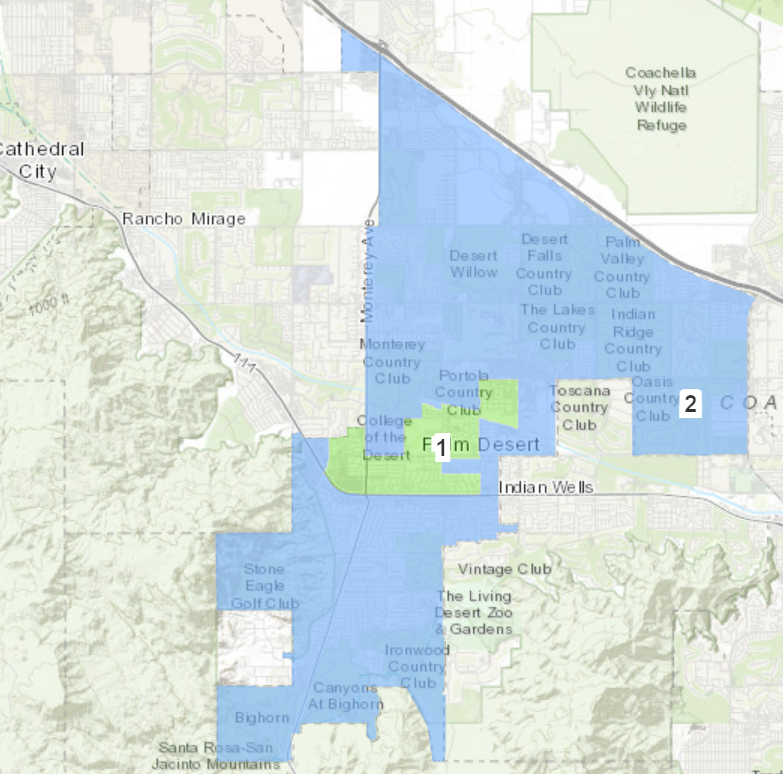Palm Desert to explore possibility of revising redistricting lawsuit settlement agreement
A new path forward in Palm Desert's redistricting debate proposed by Mayor Kathleen Kelly on Thursday would have the city pursue a deal that would create five districts by 2024, and also get rid of the ranked-choice voting system that has only been in place for one election.
The city currently has a controversial two-district system.
District 1: The smaller of the two, with about 20% of the city’s population concentrated in the city's center, is represented by one person elected every four years.
District 2: The larger of the two districts encompasses 80% of the population that totally surrounds District 1 (a "donut") and is represented by four people, with two elected at-large every two years.
Critics of this system say that District 1 voters get diminished levels of representation, having the chance to vote for only one council seat once every four years, while other voters head to the polls every two years to select two representatives.
Palm Desert historically had at-large voting for five council seats, but moved to two districts as the result of a lawsuit settlement. The city was sued in 2019 by residents Lorraine Salas and Karina Quintanilla (now mayor pro-tem), who claimed Palm Desert was in violation of the California Voting Rights Act. The act requires cities to switch to districts, grouping “communities of interest” to ensure that protected minorities have a better chance for representation.
The city held its first election for two districts in November 2019. The results of the historic vote:

District 1: Quintanilla was elected to the seat, and vowed during her campaign that, if elected, she would push for five districts.
District 2: Incumbents Gina Nestande and now-Mayor Kelly each won reelection to the council for their second four-year terms.
The city's second election under the two-district system two years later brought yet another change at the polls, also as the result of the lawsuit settlement: Residents of District 2 were the first to cast ballots for their two other seats (of the four total) using a ranked-choice voting system, which allows voters to rank up to three candidates by preference.
The results? Incumbent Jan Harnik, who has been on the council since 2010, and newcomer Evan Trubee were elected to round out the current board.
While District 1 voters didn't have an opportunity to vote on a council seat, the voters of both districts were posed a question in Measure B that had the potential to further push redistricting efforts forward: Should the city move from two districts to five districts? About 53% of voters said the city should be split into five districts, however, the ballot question was non-binding, leaving city leaders with the final say.
So, what do the voters and councilmembers want?
Palm Desert voters already have weighed in: The city's redistricting efforts need tweaking toward a five-district model, but the council has been grappling with how and when that might be achieved.
The council on Thursday revisited a proposal previously floated by Kelly that involved a move to five districts by 2030 that took into consideration expected growth on the city's north side, but failed to achieve a consensus.
Kelly said that she had put forward the growth-based approach as "a potential means to bring (the council) together." But she said if there's no version of that proposal that everyone found acceptable, she couldn't suggest a continued push in that direction.
Instead, she proposed a path forward that would see the city move to a five-district system by 2024 and do away with the ranked-choice voting system that many have criticized as confusing in how votes are tabulated.
Kelly said she thought that would be the best way to make sure that any changes would avoid a costly legal battle. “Now is the time to address it.”
So how would that be achieved? The council on Thursday passed a motion that authorizes the city's lawyers to initiate conversations with counsel for the plaintiffs in the 2019 lawsuit to propose a revised settlement to the agreement that had stipulated the two districts and ranked-choice voting.
One of those plaintiffs is Quintanilla, who was critical of Kelly's initial growth-based trigger proposal to achieve five districts by 2030, saying that the process to get to there has already taken too long, and that too much money has been spent on legal bills in the process.
"We've already delayed too long," she said. "This is our time to do it right."
She also said ranked-choice voting and the potential move to five districts are two separate issues, arguing that lumping the two together is a delay tactic.
Harnik sounded a cautionary note about the overall rancor that has surrounded the broader redistricting debate, urging the council to take the time to have an "authentic discussion."
"We can do this with calm, with kindness and with deliberation and we can come up with an answer that we will be proud of," she said.
Previous reporting by Sherry Barkas and Tom Coulter is included in this report.
This article originally appeared on Palm Springs Desert Sun: Palm Desert to explore possibility of revising redistricting settlement

